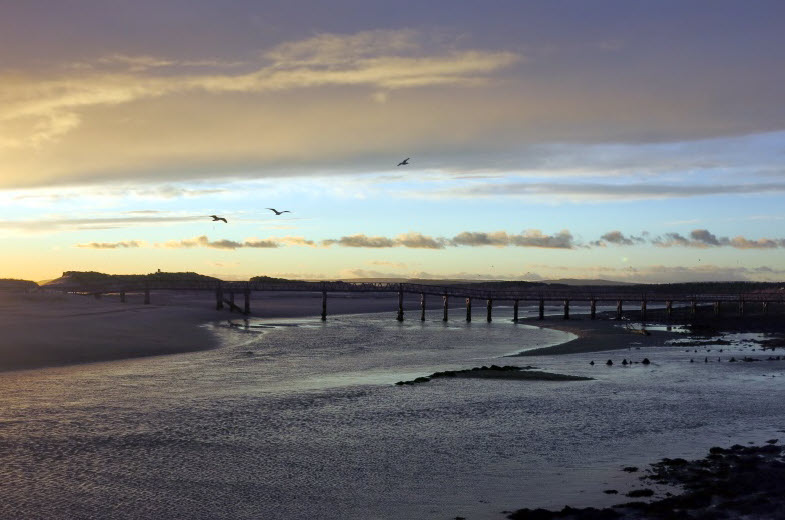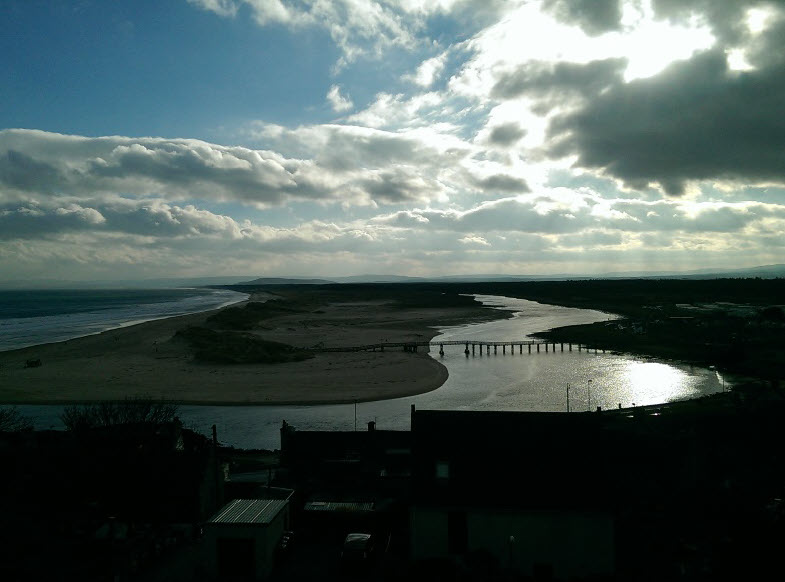
NOTE: The following article was originally published on the website of Lossiemouth Community Development Trust on 27 September 2016.
Lossiemouth Community Development Trust (“the Trust”) is a charity which began life as a registered company towards the end of 2014.
In order to work out how best to serve the community through the Trust’s charitable aims, there was a series of consultations, both face-to-face and via the internet.
One of the top priority action points identified was the need to improve and upgrade the Seatown Bridge which provides pedestrian access to the East Beach across the lower reaches of the River Lossie.
The bridge features as the image which is part of the Trust’s logo.
As well as being an iconic landmark, the bridge is essential as the only safe way to reach the East Beach on foot from the town. It is also a crucial link in public footpaths such as The Moray Coast Trail and The Moray Way.
Breaking down the need for action in relation to the bridge into separate steps, 2 major issues for the Trust were identified as:
Establishing the ownership of the bridge; and
Investigating the stability and durability of the structure of the bridge.
As it turns out, the ownership of the bridge is not a straightforward matter.
That is a subject for a separate article (but see further, below).
To assess the viability of the bridge, the Trust decided to obtain an expert assessment by a structural engineer.
This has now been undertaken by the Elgin office of consulting structural and civil engineers, Fairhurst. The report became available at the beginning of August 2016 and is based on several separate visits to the bridge during June 2016.
The main purpose of the inspection was to examine the condition of the existing structure and the requirement for any repair or reinforcement works.
The report notes that the bridge is of steel and timber construction. It spans across several timber piers. The bridge is raised in one section to provide greater clearance over the tidal waters of the River Lossie.
Sections which got a good report
The timber boarded deck of the bridge is generally in good condition and only a few boards need to be replaced.
The wooden piers on which the bridge sits are in reasonable condition and do not require any immediate attention.
Sections which did not fare so well
Some of the timber boards have worn down, leaving nails sticking up and these need to be fixed in further.
Some parts of the handrail have corroded. At best, this could be fixed by cleaning the metal back to bare steel and repainting; at worst, where sections are corroded through, they will require to be replaced.
Summary of recommendations
Even though the bridge is not at the point of falling down, a significant amount of work is needed to repair the structure.
The sections which are in a poor state of repair are likely to give rise to sharp edges and an associated risk of injury to people using the bridge. These problems are only going to become worse with the passage of time.
In broad terms, the engineering report estimated that about 15% of the steel sections under the bridge and 40% of the handrail sections already need to be replaced. For bits which don’t need to be replaced, the recommendation, as you would expect, is that all steel sections should be cleaned back to bare metal and repainted.
Practical considerations
With this being a bridge over flowing water, there will be additional considerations for anyone planning repair and replacement works as a contractor. There will also be the issue of whether, during any works, it will be possible to maintain public access via the bridge or whether it will be necessary to close the bridge for some of the time.
The report does not go into the cost implications of the bridge work which has been identified as desirable or necessary. No doubt, the costs will be significant.
Previous research carried out on behalf of Lossiemouth Community Council suggests that, when Moray Council obtained quotes for replacement of the bridge in 1992, the lowest estimate was for £388,000. When the bridge was last repaired – in about 1995 – the cost was around £150,000.
These amounts have not been independently checked by us but the point we hope they make (20 to 25 years later) is that significant repairs to the bridge – or its replacement – are going to cost A LOT of money.
Safety considerations
Though not the main focus of this article, the Trust’s research indicates that the current ownership of the bridge is unclear.
The last known owner of the ground on which the bridge sits is The Lossiemouth Old Harbour Commissioners. They acquired their title from the Government (Board of Trade) in 1915.
Though the Moray Council (and its predecessors) has paid for works on the bridge from time to time in the interim, title searches have not revealed it to be owner of the bridge. Just because the Council has paid to maintain the bridge in the past does not mean it has any current or future obligation to do so.
The Lossiemouth Old Harbour Commissioners no longer exist as a legal entity and it is most likely that ownership of the bridge has passed to the Crown – because “ownerless” land in Scotland reverts to the Crown.
The Crown’s representative in Scotland for this sort of thing is the Queen’s and Lord Treasurer’s Remembrancer (“QLTR”). QLTR does not have to deal with property in any particular way – or even look after it.
As things stand, the best advice to users of the bridge is probably to say that the bridge is still safe, provided you take care. You should watch out in particular for sharp points and edges, which might cut you.
Given the uncertainty about ownership of the bridge and current responsibility for the bridge, you should bear in mind that, if you suffer injury while using the bridge, it may be very difficult for you to establish a claim against anyone.

Leave a Reply